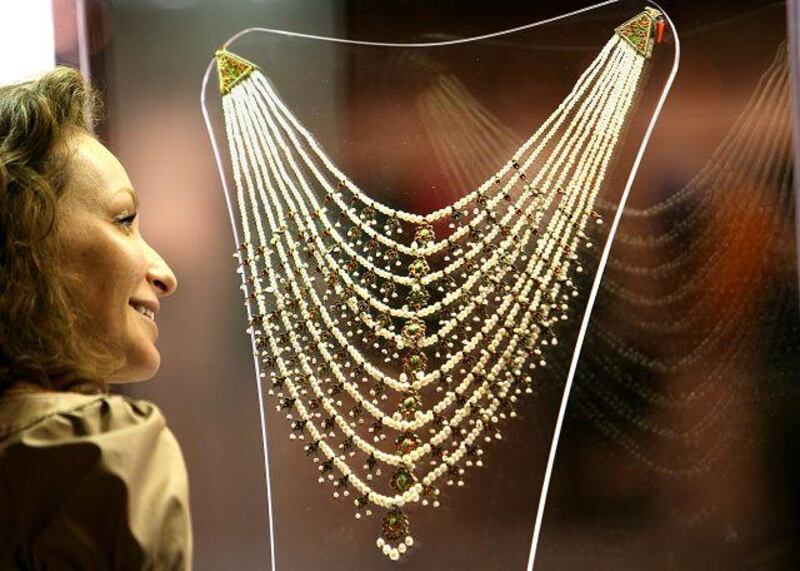The rich traditions and heritage of the Emirates' pearling industry are about to be revived with a new visitor centre as international experts gather in Dubai to decide how to make the gem fashionable again. Pearls, the backbone of the region's economy until the discovery of oil, will be celebrated at the museum and tourist centre, which has been touted for The World development. Dubai will also look to the future of the pearl industry, with the first World Pearl Forum next month at Atlantis, The Palm, drawing experts from around the world looking to give pearls a more modern image for younger women.
The Dubai Multi Commodities Centre (DMCC), an arm of the Dubai Government, said the tourist centre, which would also sell a selection of pearls, could make the historic trade lucrative again. Gaiti Rabbani, the executive director of DMCC's coloured stones and pearls section, said the pearl trade fascinated Emiratis and tourists alike. "People used to come from all over the world for the pearls found here," Ms Rabbani said. "Locals were involved in every aspect of the industry, from traders to ship captains and divers. Those were gruelling times.
"There is still a lot of excitement and passion in this region about the industry, as most Emiratis who retrace their family trees will find their grandfathers were involved in some aspect of it. "Eighty per cent of the economy was based on it and in Dubai, a lot of the community was structured around the pearl trade. It is such a romantic industry yet there is so little awareness about it." Ms Rabbani said the visitor centre would be "very arty and contemporary, using technology as an entertainment tool".
"It is still at the conceptual stage but it will be a tribute to the pearling heritage and experience of divers." Until oil was discovered, Dubai, Abu Dhabi and Manama were at the forefront of the world's pearl trade, Ms Rabbani said. Natural pearls are not commercially harvested anywhere in the world. Harvesting is more expensive than cultivating pearls, which has been perfected in countries such as Japan and Australia.
The size and quality of the natural pearls were unpredictable as they could be affected by water temperature and pollution. These days natural pearls are a rarity, fetching enormous prices from collectors and are still highly prized by UAE royalty. Despite pearl prices plummeting by 60 per cent, a natural pearl necklace formerly owned by the Egyptian singer Umm Kulthum sold at auction by Christie's in Dubai last year for Dh5.1 million (US$1.4m). Ms Rabbani said that with its industry heritage and culture, the UAE was a natural setting for the first World Pearl Forum.
"The industry is very fragmented with no international body, so with our heritage and culture here, it made sense to create a forum here and set up the Dubai Pearl Exchange last year," she said. "Ironically, Dubai's man-made islands have created new environments where oysters are breeding at a healthy rate, but it is not commercially viable to farm them. "It would take years to set up a viable operation. What we do have is an opportunity to play a role in the global industry."
The forum will discuss how to make pearls appeal to a younger generation, as well as their history. "They have long been associated with women of a certain age. We want to change that traditional image," Ms Rabbani said. She added that the tourist centre would be contemporary and interactive, using technology to entertain and educate visitors. "It is still at the conceptual stage but it will be a tribute to the pearling heritage and experience of divers," she said.
The pearl trade is worth about $3 billion annually, but that is only two per cent of the global jewellery market. Natural pearls are formed when microscopic parasites enter the shells of oysters, which then repeatedly secrete chemicals to coat the irritant, creating the jewel. They come in many shapes, with perfectly round ones a rarity. Until the early 1950s, pearl divers in the UAE equipped with nose pegs, wax earplugs and lead weights would spend up to three minutes a time under water, going down as deep as 20m and risking their lives to search for pearls.
During the pearl boom in the 19th century there were about 7,000 divers in Dubai. With the renewed interest in pearls, a new generation of Emiratis has been exploring its pearl-fishing heritage through the recent revival of free-diving, which involves descending into deep water without the aid of oxygen tanks. Classes have been held in Abu Dhabi with divers then heading to Fujairah to some of the best known diving sites in the UAE.
In the early 1900s, the Japanese discovered they could create perfectly rounded pearls by inserting a fragment of mussel shell into the molluscs, mimicking the natural process. The cultivated pearl was born and devastated the market for natural pearl farming. The two-day World Pearl Forum, starting on Feb 17, will be preceded by an auction of rare and precious gems and a play based on the life of a pearl diver.
tyaqoob@thenational.ae






